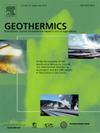Numerical simulation and thermal control factor analysis of deep high-temperature geothermal energy in the Zhenghe-Dapu fault zone and its adjacent areas, Southeast China
IF 3.5
2区 工程技术
Q3 ENERGY & FUELS
引用次数: 0
Abstract
The coastal area of Southeast China, characterized by high heat flow and extensive magmatic activity, has long been a focus of geothermal research. However, the formation mechanisms and geological controls governing deep high-temperature geothermal resources in this region remain poorly constrained, posing challenges for accurate resource assessment. Here, we built a two-dimensional lithospheric geological model integrating geological, seismic, and magnetotelluric data to quantify key thermal controls. Simulations reveal significant high-temperature anomalies in the Wuyishan and Coastal terranes, with temperatures exceeding 180°C at 5 km depth and surface heat flow surpassing 80 mW/m². These anomalies result from asthenospheric upwelling, facilitated by a thinned lithosphere, which delivers 73–92 mW/m2 of mantle-derived heat flow. Additionally, Late Mesozoic-Cenozoic magmatic intrusion elevate shallow crustal temperatures by 31–43 °C, while the Zhenghe-Dapu shear zone with anisotropic high thermal conductivity along mylonitic foliation, acts as a deep heat conduit, forming localized 205 °C anomalies. Overlying low-thermal-conductivity sedimentary cover further insulates the system, sustains elevated temperatures, and modulates surface heat flow variations by ∼30 %. This study provides new constraints on deep high-temperature geothermal formation and offers key indicators for identifying favorable geothermal targets and optimizing resource assessment.
郑和-大浦断裂带及邻区深部高温地热能数值模拟及热控因子分析
东南沿海地区热流大、岩浆活动广泛,一直是地热研究的热点。然而,该地区深层高温地热资源的形成机制和地质控制因素尚不清楚,为资源的准确评价带来了挑战。在这里,我们建立了一个二维岩石圈地质模型,整合了地质、地震和大地电磁数据,以量化关键的热控制。模拟结果显示武夷山和沿海地区存在明显的高温异常,5 km深度温度超过180℃,地表热流超过80 mW/m²。这些异常是由软流圈上升流造成的,由变薄的岩石圈促进,提供73-92 mW/m2的地幔衍生热流。此外,晚中生代—新生代岩浆侵入使浅部地壳温度升高31 ~ 43℃,而正和—大浦剪切带沿糜棱岩理面构造具有各向异性高导热性,是深部热传导通道,形成局部205℃异常。上覆的低导热沉积层进一步隔离了系统,维持了高温,并将地表热流变化调节了约30%。该研究为深部高温地热形成提供了新的约束条件,为寻找有利地热靶区和优化资源评价提供了关键指标。
本文章由计算机程序翻译,如有差异,请以英文原文为准。
求助全文
约1分钟内获得全文
求助全文
来源期刊

Geothermics
工程技术-地球科学综合
CiteScore
7.70
自引率
15.40%
发文量
237
审稿时长
4.5 months
期刊介绍:
Geothermics is an international journal devoted to the research and development of geothermal energy. The International Board of Editors of Geothermics, which comprises specialists in the various aspects of geothermal resources, exploration and development, guarantees the balanced, comprehensive view of scientific and technological developments in this promising energy field.
It promulgates the state of the art and science of geothermal energy, its exploration and exploitation through a regular exchange of information from all parts of the world. The journal publishes articles dealing with the theory, exploration techniques and all aspects of the utilization of geothermal resources. Geothermics serves as the scientific house, or exchange medium, through which the growing community of geothermal specialists can provide and receive information.
 求助内容:
求助内容: 应助结果提醒方式:
应助结果提醒方式:


